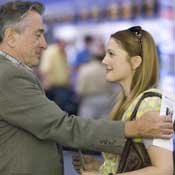While "Everybody's Fine" may appear to be a light-hearted comedic drama, it plays out more like real life: full of ups and down with a little humor strewn here and there.
Robert DeNiro is Frank Goode, an unassuming middle-class retiree and a recent widower. Drew Barrymore, Kate Beckinsale and Sam Rockwell complete the cast, playing Goode's adult children. Goode is adjusting to the harsh reality that his family is drifting apart, and he must take on the role his wife carried of keeping the family together.
Writer and director Kirk Jones (Nanny McPhee, Waking Ned) does a good job of remaking the 1990 Italian film "Stanno tutti bene" and transitioning it to what is likely to become an iconic American movie.
We are introduced to Goode as he goes about mowing his lawn and watering his garden. While he is grocery shopping, we learn that he is preparing for a visit from his children. Wanting to bring the family around the same table again, he tries to plan the perfect dinner. His plans slowly disintegrate as each of his children, one by one, calls with an excuse. It is then that Goode realizes that not only has he lost his wife, but he also has lost the connection with his children. Despite his doctors warning to avoid travel and anything that might be overwhelming, Goode sets out to see his children and bring them together for Christmas.
Jones does a good job of presenting each scene with careful thought and preparation, allowing viewers to build a deeper connection with Goode and his children. The film resembles a play, moving in an unhurried fashion and giving as much attention to detail as possible. The symbolic nature of telephone wires is used to connect scenes, creating an even flow throughout the film.
In many scenes Goode's children are shown as he remembers them best, as young children. This technique adds a sense of longing and possible remorse to the scenes. Jones' writing and direction for this movie is complemented by its score, thanks to music editor James Bellamy ("V for Vendetta," "Pride & Prejudice"). Bellamy meticulously balances the music, making sure each musical decision does not dominate, but enhances.
Goode's journey is more than just a visit to see his children. His loss motivates the journey, as well as fear that he will die without ever truly knowing his children. He is given a chance to look into his past and see the outcome of his decisions and actions.
Wanting their father to be proud of them, his children work to make their lives seem flawless and their jobs just what their father would have wanted. Not wanting to hurt their father with the truth, he is seemingly pushed asidetheir busy lives taking first priority.
The kids go to great lengths to turn their charade into real life while their father is visiting. Goode carefully observes and seems oblivious to their charade, but like most parents, he knows they are not being completely truthful. With each child's visit, he begins to realize that the dreams he had for his children and the dreams they had for themselves have gone in different directions. Is it too late to make things right?
This movie is set between Thanksgiving and Christmas, and is a reminder to viewers of how fragile the family really is and that you shouldn't wait until everyone is grown up and gone to really get to know them and become close to them.
That message comes subtly, like spice thrown into a dish to add a little flavor. While other movies that are funnier or more spectacular in cinematography may overshadow "Everybody's Fine," this memorable film serves as a mirror for all families. It makes one wonder whether someone is being truthful when they tell you that everybody's fine.



Comments
Use the comment form below to begin a discussion about this content.